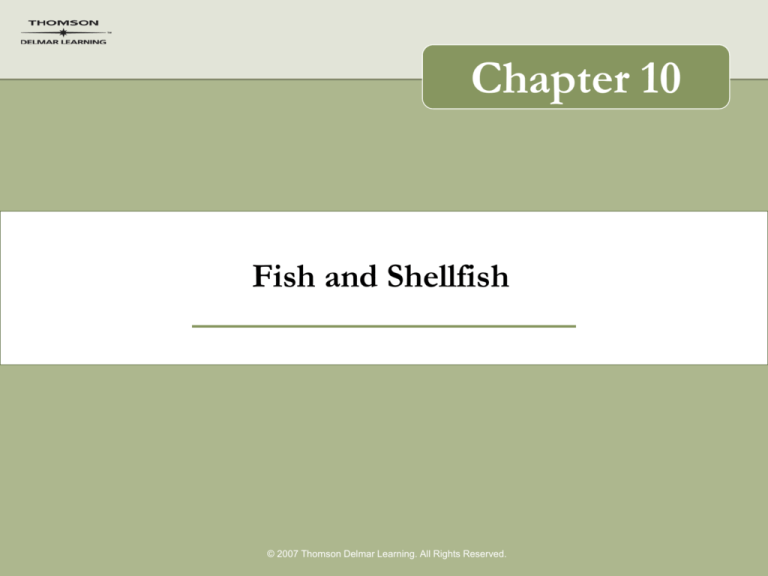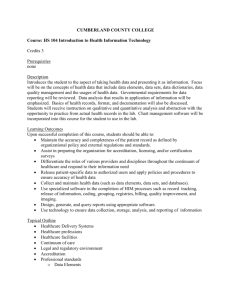
Chapter 10
Fish and Shellfish
© 2007 Thomson Delmar Learning. All Rights Reserved.
Market Forms of Fresh Fish
• Whole: the fish is literally untouched, without
anything removed
• Drawn: viscera/entrails/gut have been removed
and stomach cavity cleaned
• Dressed: gut, all fins, and scales are removed;
sometimes head and tail also
• Filleted and Trimmed: the flesh is removed from
the bone and trimmed into fillets; skin also is
removed at this stage
• Portioned: fillets are cut into specifications
© 2007 Thomson Delmar Learning. All Rights Reserved.
Market Forms of Shellfish
• Alive and Well: should be purchased and
received alive
• Shucked or Shelled: removed from shell and
cleaned appropriately
© 2007 Thomson Delmar Learning. All Rights Reserved.
Classification of Fish
• Round White
–
–
–
–
Vertical backbone
Fillet on either side
One eye on each side of the head
Flesh is white in color
© 2007 Thomson Delmar Learning. All Rights Reserved.
Classification of Fish
• Round Oily
–
–
–
–
Vertical backbone
Fillet on either side
One eye on each side of the head
Flesh varies in color from shades of red to dark
purple to off-white
– Fat content varies from 26% for eel family to
12% for salmon family to 6% for herring family
© 2007 Thomson Delmar Learning. All Rights Reserved.
Classification of Fish
• Flat White
– Horizontal backbone with 2 fillets on either side
– Both eyes on the topside of the head
– Light-colored skin underneath, dark on top
• Non-Bony
– Have cartilage instead of bone
– Examples: shark, rays
© 2007 Thomson Delmar Learning. All Rights Reserved.
Handling and Storage
• Fresh Fish
–
–
–
–
–
–
–
Cleaned and gutted to preserve freshness
Gills should also be removed
Should be received on self-draining ice
Should be refrigerated at 35ºF to 40ºF as soon as received
Seal in plastic wrap if skinned when received
Should not come in contact with other foods
Should not be exposed to air unnecessarily
© 2007 Thomson Delmar Learning. All Rights Reserved.
Handling and Storage
• Frozen Fish
– Should be wrapped and sealed in moisture-proof
and vapor-proof material
– May be frozen by glazing
– Commercially frozen should be placed in freezer
in their original packaging, immediately after
purchase
– Store at 0ºF
– Date packages for easy rotation
© 2007 Thomson Delmar Learning. All Rights Reserved.
Quality Points for Selection
•
•
•
•
•
•
•
•
Eyes should be bright and full, not sunken
Gills should be bright pinkish red in color
Flesh must be firm and springy, or elastic
Scales, if any, should be plentiful and firm and
should not come off when handled
Should have a pleasant, salty smell
Skin should be shining and have a good color
Flesh of white fish should be really white, not
yellowish
Should feel heavy in relation to size
© 2007 Thomson Delmar Learning. All Rights Reserved.
Staleness Indicators
•
•
•
•
Unpleasant ammoniac odor
Limp flesh retaining imprint
Sunken eyes with loss of clarity
Gills will be dull and discolored
© 2007 Thomson Delmar Learning. All Rights Reserved.
Quality Points for Selection of
Shellfish
• Confirm that they are alive
– Crustaceans, such as lobsters, should be lively and
defensive
– Bivalves, such as mussels and clams, should generally have
tightly closed shells—tapping an open one should cause it
to close quickly
– Univalves, such as snail and conch, are difficult to
assess—poking the protected flesh in and around the
aperture should cause a rapid withdrawal response
– During cooking process of bivalves, the shells must open
during boiling; if not they should be discarded
© 2007 Thomson Delmar Learning. All Rights Reserved.
Potential Yield of Fish
• Yields will vary:
–
–
–
–
–
According to classification—flat or round
According to species
As size increases
Depending on cut used
If processed by inexperienced craftsperson
© 2007 Thomson Delmar Learning. All Rights Reserved.
Yield Calculations
• Weight loss from scaling is 2%
• Weight loss from skinning is 11% to 13%
• Weight loss from gutting is 13% to 16%
© 2007 Thomson Delmar Learning. All Rights Reserved.
Fish Fabrication
• Evisceration:
– Wash and dry the fish with a clean cloth
– Cut off all fins and trim the tail
– Remove the eyes and trim the mouth if the fish is to be
served whole
– Remove the scales, if any, scraping with a knife or other
scaling hook held at a 45º angle from tail to head
– Remove the gills and entrails from the fill slits, also the
roes, if any
© 2007 Thomson Delmar Learning. All Rights Reserved.
Fish Fabrication
• Evisceration:
– Remove the gills and stomach from a round fish,
by making a small opening 2 inches in length
from the vent to the belly; remove the gut and
the roe with care so as not to damage it and
create spillage
– In the case of a flat fish, make the opening
immediately behind the head of the fish where
the gut is situated
© 2007 Thomson Delmar Learning. All Rights Reserved.
Fish Fabrication
• Open the gill slit, on one side of the back of the
head, with the fish on its side on the cutting board
• Hold the gills firmly with the fingers of the left
hand and with the fish shears cut the gill loose from
both the left side, where it is attached to the throat,
and the right side, where it is attached to the back of
the gill slit
© 2007 Thomson Delmar Learning. All Rights Reserved.
Fish Fabrication
• Evisceration
– Repeat this operation on the other side of the
fish until the gills are free
– Using the tip of the knife and the thumb, draw
out the entrails and the gills gently, taking care
not to damage the flesh of the fish
– Take care not to break the gut sack because this
will create spillage and enhance spoilage
© 2007 Thomson Delmar Learning. All Rights Reserved.
Fish Fabrication
• Evisceration
– Wash the interior of the fish thoroughly under cold
running water and while scraping the backbone with a
knife to remove all traces of blood or liver from the
backbone.
– Rewash and dry the fish with a clean cloth.
– Ice down and refrigerate
– Any roe removed from the fish should be placed into
cold water at once and rinsed with cold water until the
rinse water runs clear
© 2007 Thomson Delmar Learning. All Rights Reserved.
Skinning Round Fish
• Remove all dorsal, pelvic, and anal fins with a strong
pair of shears
• Make an incision with the tip of a knife around the
head, loosening the skin from the head
• Now loosen the skin along the length of the cut;
then, starting at the head, pull the skin toward the
tail in one stroke to remove the whole half-skin
neatly
• Repeat on the other side
© 2007 Thomson Delmar Learning. All Rights Reserved.
Skinning Flat Fish
• First remove all fins from the fish using a sharp,
strong pair of shears.
• Cut through the skin across the middle of the tail
and, with the tip of the fillet knife, scrape across the
tail to loosen a few inches of skin
• Now raise the skin from the flesh, placing the
thumb of the right hand between the flesh and the
skin
• Hold the tail in the left hand; pull gently with the
right hand and remove the skin cleanly from the
flesh
© 2007 Thomson Delmar Learning. All Rights Reserved.
Skinning Flat Fish
• Follow along the fish with the thumb of the
left hand, loosening the skin from the fins on
either side of the fish
• The use of a little salt on the fingers, or
better still, a clean cloth will ensure a firmer
grip on the fish while skinning it
• If salt is used to enhance grip, always wash
salt off skin before using it to make stock
© 2007 Thomson Delmar Learning. All Rights Reserved.
Filleting Round Fish
• Ensure the fish has been washed and dried very well
before beginning
• Remove all fins and scales from the fish with sharp
scissors and a scaling tool
• Make an incision along the backbone from the head
end to the tail, keeping your knife on the bone at all
times
• Continue to deepen the incision, scraping your knife
over the fish ribs, holding the freed flesh in your
other hand until the fillet starts to come free
© 2007 Thomson Delmar Learning. All Rights Reserved.
Filleting Round Fish
• Follow the bones without cutting the flesh
until the whole fillet is removed
• Repeat the process on the other side
• This technique will yield 2 fillets
© 2007 Thomson Delmar Learning. All Rights Reserved.
Filleting Flat Fish
• Remove all fins from the fish and dry well
• Make an incision down the center of the backbone from
head to tail
• Separate the flesh from the bone, moving the knife down the
length of the fillet, moving back the flesh as you go
• Continue to cut outward toward the fins, making sure your
knife always stays on the bone until the fillet is completely
removed
• Remove the other fillet from that side by turning the fish
around and starting from the tail to the head
• Remove both fillets from the other side, yielding a total 4
fillets
© 2007 Thomson Delmar Learning. All Rights Reserved.
Filleting Large Fish
• Use a larger knife with a rigid blade and very
fine edge
• Always remove fins, scales, and any barbs
• Use sharp strong poultry shears to aid in
trimming the fish
• Try to support the fillet as it is being removed
to prevent it from splitting
• Work on a very stable surface
© 2007 Thomson Delmar Learning. All Rights Reserved.
Filleting Large Fish
• Wear good gloves for better grip
• Make sure the fish is as dry as possible
© 2007 Thomson Delmar Learning. All Rights Reserved.
Cuts of Fish
• Whole: appropriate when portion size and shape fit
the plate
• Darne: steak, sometimes called Côtelette; a slice
from a large round fish on the bone
• Demi-Darne: cut in half through the spine; done
when the darne is too big for the plate
• Tronçon: a slice or steak cut from a large flat fish
on the bone
• Fillet (filets): boneless, skinless portion of the fish
achieved by completely boning the fish
© 2007 Thomson Delmar Learning. All Rights Reserved.
Cuts of Fish
• Double Fillet: removing 2 fillets at a time, leaving
them attached, sometimes with skin on
• Suprême (Medallion): applied to large fillets both
from flat and round varieties
• Boneless Darne: produced by butterflying a
suprême into the shape of a darne
• Goujon: strips of fish cut 3 inches × ¼ inch
• Paupiette: applied to fillets of fish that are rolled
and stuffed with mousseline or forcemeat into a
barrel shape
© 2007 Thomson Delmar Learning. All Rights Reserved.
Cuts of Fish
• Plié: applied to fillets that are folded slightly
flattened and then folded in two
• En Tresse (Pleated or Braided Fillets): a fillet is cut
into 3 strips, leaving them attached at one end and
then braided or pleated for a fine presentation
• Tournedo: using red-flesh fish cut into circles
approximately 3 inches in diameter
• Mignon: folded fillet, as for a cornet or triangular
shape somewhat like a piping bag
© 2007 Thomson Delmar Learning. All Rights Reserved.
Cuts of Fish
• Delice: neatly folded, trimmed fillet that will be
poached
• Galette (Towered Fish): small fillets of equal size
and width, or lightly beaten pieces of a larger fillet,
and layered on top of one another with mousseline
spread between each layer
• Farci (Stuffed Whole): applied to small whole fish
after boning and skinning, but with head and tail still
attached; is stuffed with mousseline and reshaped
© 2007 Thomson Delmar Learning. All Rights Reserved.
Cuts of Fish
• Skin-Wrapped Fillet: large fillet of fish is used; belly is cut
from the skin, leaving a square piece of fish about 2 inches
on all sides; wrap the exposed fish with the flap of skin and
tie well with string
• Tartare of Fish: made from fish flesh that has been neatly
cut into small dice, and seasoned with spices and other
flavoring agents; served raw
• Medusa-Style: fillet and skin whole fish, leaving head
attached; cut each fillet into three strips (goujons) and dip in
light batter to deep fry; serve upside-down, displaying
goujons representing the snakes protruding from Medusa’s
head
© 2007 Thomson Delmar Learning. All Rights Reserved.
Cuts of Fish
• Shaped Fish Fillets: trimmed fish fillets,
which are then cut accurately into circles,
diamonds, triangles, etc., with the trim used
for other dishes
© 2007 Thomson Delmar Learning. All Rights Reserved.
Prepared Fish
• Colbert-Style (small flat fish):
– Clean and prepare fish in the normal way
– Skin; remove fins
– Make an incision along the backbone on one side,
as if to fillet, within an inch or so from sides and
ends of sole
– Neatly fold back fillets
– Break backbone in 2 to 4 places, for easier
removal after cooking
© 2007 Thomson Delmar Learning. All Rights Reserved.
Prepared Fish
• Wash, dry, season, flour, egg wash, and
crumb
• Deep-fry whole fish
• When fully cooked, remove broken spine to
expose cooked white fillets
• Place colored compound butters within and
serve
© 2007 Thomson Delmar Learning. All Rights Reserved.
Prepared Fish
• Colbert-Style (small round fish):
–
–
–
–
Skin fish or leave skin on, as desired
Remove gills and eyes
Wash and dry fish
Carefully remove the whole backbone, leaving 1 inch of the
backbone and both fillets still attached to head and tail
– Season, flour, egg wash, and bread crumb the whole fish
– Apply vegetable spray to an ovenproof pan and stand coated fish as
though it were swimming, but open to separate the two fillets
– Bake until done
© 2007 Thomson Delmar Learning. All Rights Reserved.
Prepared Fish
• Curled Small Round Fish:
–
–
–
–
–
–
–
Skin as desired
Remove gill and eyes; force a knife through eye socket
Wash, dry, and season
Flour, egg wash, and bread crumb
Push tail through eye socket
Secure, if necessary, with cocktail pick
Deep-fry or bake until done
© 2007 Thomson Delmar Learning. All Rights Reserved.
Colere Small Round Fish
• Prepare as Colbert round fish
• Place tail between needle-sharp teeth of fish
• Bake until done
© 2007 Thomson Delmar Learning. All Rights Reserved.
En Lorgnette Small Round Fish
• Clean and skin as described
• Remove backbone, leaving fillets attached to
head
• Season, flour, egg wash, and breadcrumb
fillets
• Roll each fillet toward head—the two fillets
representing the glasses of a pince-nez, the
head, and the handle
© 2007 Thomson Delmar Learning. All Rights Reserved.
Shellfish
• Mollusks
– Two forms of mollusks:
• Bivalves
• Univalves
– Shells
– Invertebrates
– Bodies divided into 4 sections: head, muscular foot,
intestinal sac, and “mantle”
– Respiration through gills
© 2007 Thomson Delmar Learning. All Rights Reserved.
Bivalves
•
•
•
•
•
•
8,000 species
Second largest class of mollusks
Shell consists of 2 parts joined by a dorsal hinge
When closed, completely covers shellfish
As a rule are immobile
When they do move, it is by means of the foot,
which is stretched as far forward as possible, and
then anchored to the ground or stationary object, so
that the creature can drag itself slowly forward
© 2007 Thomson Delmar Learning. All Rights Reserved.
Univalves
•
•
•
•
105,000 known species
Largest class of mollusks
Spiral, univalve shell
Some gastropods without shells, some with
simple shells
© 2007 Thomson Delmar Learning. All Rights Reserved.
Crustaceans
• Shrimp, crab, lobsters, crayfish, amphipods, isopods,
ostracods, and barnacles
• 50 million species
• Shrimp, spiny and clawed lobsters, crayfish,
common crabs, hermit crabs, robber crabs, spider
crabs, mitten crabs, and stone crabs all belong to the
order of decapods
• Decapods move by swimming, crawling, strutting,
or raking through soft ground
© 2007 Thomson Delmar Learning. All Rights Reserved.
Cooking Live Lobsters
• Classic Method: cut through nerve center by
inserting a sharp, heavy knife where the head meets
the body
• Safest Method: To protect roe of female lobster,
plunge the lobster into vigorously boiling court
bouillon just long enough to set the proteins of the
flesh; allow the liquid to return to boil after lobsters
are added, and simmer for 2 to 3 minutes
© 2007 Thomson Delmar Learning. All Rights Reserved.
Cooking Live Lobsters
• To fully cook a lobster by boiling:
–
–
–
–
Allocate at least 1 gallon (3.8 L) of water per lobster
The flame must be set on high under the pot
The liquid must be fast boiling before the lobster is added
Hold under water for at least 2 minutes if blanching; the
lobster should die within 15 seconds
• If another preparation method is needed, remove after 2 minutes
• For finished dishes, cook for an additional 6 minutes; shock to
prevent overcooking
© 2007 Thomson Delmar Learning. All Rights Reserved.
Cooking and Cleaning Crabs
• Boil in salt water or sea water; if using tap water,
add ½ cup (118 mL) of kosher salt to every gallon
(3.8 L) of water
• Let boil for 5 minutes, then cool quickly under
running tap of cold water
• Cleaning:
– Hold the crab firmly in one hand and slide a sharp knife
under the shell with the other
– Use the knife as a lever to prize off the shell
– Pull the shell away from the body
© 2007 Thomson Delmar Learning. All Rights Reserved.
Cooking and Cleaning Crabs
• Cleaning:
–
–
–
–
–
Remove and discard the “feathery” internal gills
Twist off all the legs and the claws
To expose the body’s white meat, cut it in half
Open and separate the halves
Dig out the white meat from the halves using the point
of sharp knife
– Crack the claws and legs with a hammer or nutcracker
and extract their meat
© 2007 Thomson Delmar Learning. All Rights Reserved.
Cleaning Shrimp
• The head may be removed by using thumbs
or a sharp knife
– Place a thumb under the head, between the
body’s shell and plate-like head, and quickly flick
the thumb as if to toss a coin
– Place the knife’s tip in the same location and
forcefully cutting will sever the head
© 2007 Thomson Delmar Learning. All Rights Reserved.
Cleaning Shrimp
• Peeling:
– Straighten shrimp’s body and pull apart the shell,
starting between the legs
• Deveining:
– Make a shallow incision along the “back” to
remove the contents of the alimentary canal
(digestive system) that runs from head to tail,
down the back edge of each shrimp; scrape away
the dark entrails
© 2007 Thomson Delmar Learning. All Rights Reserved.
Opening and Cleaning Scallops
• To open the shell, hold the scallop with the flat shell
uppermost
• Probe between the shells with a short knife to find a
small opening; insert the blade and run it across the
roof of the shell
• Separate the 2 halves of the shell and pull apart
• Slide the blade under the grayish outer rim of the
flesh, called the skirt, to free the scallop; pull away
the muscle with a small knife
© 2007 Thomson Delmar Learning. All Rights Reserved.
Shucking Oysters
• It is necessary to exert a lot of pressure to open oyster shells,
so it is important that the angle of the knife, as well as the
positioning of the towel holding the oyster, is given special
attention, especially for safety reasons
• Wrap the oyster in a towel and place it securely on a flat
cutting surface with the small indentation in the end of the
oyster facing outward; place the tip of the knife in this
indentation.
• Using a good deal of pressure, push the knife into the hinge;
twist the knife back and forth in order to pry open the shell
© 2007 Thomson Delmar Learning. All Rights Reserved.
Shucking Oysters
• Hold the oyster firmly on the cutting board to keep it from
slipping or sliding away
• Once the hinge is popped, pry the lid open wide enough to
fit the top of your thumb inside; insert your thumb into the
oyster to hold the lid open; do not plunge the knife into the
the oyster once the hinge is popped
• Slide the tip of the knife inside the oyster; keep tip slanted
upward and slide it along the roof of the oyster; allow the
knife to glide along the roof of the shell until it reaches the
muscle that connects the two shells, then slice through the
connective muscle
© 2007 Thomson Delmar Learning. All Rights Reserved.
Shucking Oysters
• Cut the muscle from the top shell without
piercing the oyster itself
© 2007 Thomson Delmar Learning. All Rights Reserved.
Cleaning Mussels
• Just before cooking, soak mussels in fresh water for
about 20 minutes.
• To remove the beard, using a dry towel, grasp the
beard and give a sharp yank out and toward the
hinge end of the mussel; discard
• Remove the mussels from the water; do not pour
through a straining device because the sand has
sunk to the bottom of the bowl; place in another
bowl of clean, cold water
© 2007 Thomson Delmar Learning. All Rights Reserved.
Cleaning Mussels
• Once the mussels have been soaked, use a
firm brush to brush off any additional sand
or barnacles
• Rinse the mussels under cool tap water and
set aside
• Dry with a towel before cooking
© 2007 Thomson Delmar Learning. All Rights Reserved.
Cleaning Conch
• Hold the shell on a flat surface or, if you are
experienced, hold in your hand, with the open hold
side down
• Tap a hole in the top of the shell between the third
and fourth ring up from the pointy tip
• The hole must be wide enough to insert a knife or
machete (about 2 inches across the shell and ½
inches wide) to cut the abductor muscle, which
connects the meat to the shell
© 2007 Thomson Delmar Learning. All Rights Reserved.
Cleaning Conch
• Insert your knife, cut the muscle, and pull the meat
from the hole in the large opening by pulling it out
by its black claw
• Cut around the hard conch meat to remove the
loose hanging black and white viscera
• With the face up to you and claw away from you,
completely cut off the projecting proboscis (long
snout) and eyes; do not remove the claw yet because
it can be used as a handle while working with the
meat
© 2007 Thomson Delmar Learning. All Rights Reserved.
Cleaning Conch
• Make a small slit into the body of the meat
from the base of the proboscis, below where
the mouth was, to the ragged edge of the
muscle and remove the esophagus
• This will leave you with one piece consisting
of a white upper body and a dark gray lower
body
© 2007 Thomson Delmar Learning. All Rights Reserved.
Cleaning Conch
• Make a slit down the length of the gray portion of
the muscle about 1 inch deep and work your thumb
underneath to pull this outer gray layer off; hold the
claw firmly and use as a handle during this process
• Cut the claw from the meat, unless you choose to
eat it scorched or raw, in which case you can use it
as a handle to enjoy fresh from its shell
© 2007 Thomson Delmar Learning. All Rights Reserved.
Cleaning Squid
• Remove the tentacles by cutting off where they connect to
the body
• Cut off the head with a sharp knife; cut off the fins
• Pull out the gladius (or pen); this is the clear, plastic-looking
blade that runs the length of the body
• Pull out the rest of the innards
• Rinse the tentacles, mantle (body cavity), and fins in fresh
water, making sure that the inside of the cavity is very clean
and free of all membrane, stomach, and body fluids
© 2007 Thomson Delmar Learning. All Rights Reserved.
Cleaning and Preparing Octopus
• Wash and dry well
• Tenderize by beating on a large rock holding the
octopus by an alternate tentacle every 4 to 5 strokes
until you have beaten it by all tentacle about 50
strokes in all
• Remove the tentacles just below the eyes, separating
the head and body sections
• Cut out the eyes and clean the body cavity
thoroughly
© 2007 Thomson Delmar Learning. All Rights Reserved.
Cleaning and Preparing Octopus
• At the top of the tentacles where they join each
other, locate the beak and remove by pushing it
through the joint and exposing it
• Cut into sections for cooking method, washing well,
especially the tentacles, which will contain some
sand
• The skin on the octopus is very difficult to remove
when raw; use a little salt to assist grip
© 2007 Thomson Delmar Learning. All Rights Reserved.
Cleaning and Preparing Octopus
• Parboiling for 5 minutes will help with the
skin’s removal
• Small octopus can be left whole, splitting the
body and removing the gut from the cavity;
remove the eyes and the beak; clean well
© 2007 Thomson Delmar Learning. All Rights Reserved.
Cleaning and Preparing Fresh Abalone
• Force a sharp blade tip in the thin part of the shell
and separate the muscle from the shell
• Remove the flesh and clean well, taking out the
intestine and the sucker pad that appears as a dark
heel on the side
• Wash the flesh well and slice horizontally in two as
evenly as possible
• Place each one into heavy plastic and beat with a
mallet until very well pounded and limp
© 2007 Thomson Delmar Learning. All Rights Reserved.
Removing Roe from Sea Urchin
• Turn urchin over to expose mouth (5 teeth in its
opening)
• With a pair of powerful pointed pliers, break the
shell upward in the largest pieces you can, trying not
to create any splinters
• This will expose the roe and innards (the roe will
resemble the segments of an orange); remove the
roe from the shell using a spoon.
• The innards will also come with the roe; place roe
and innards on a clean wire rack and discard the
shell
© 2007 Thomson Delmar Learning. All Rights Reserved.
Removing Roe from Sea Urchin
• Using tweezers, carefully remove the larger and
smaller specks of innards from the roe
• Carefully lower the roe into a bath of very cold
water, and gently swill them around to clean; do not
run water directly on the roe because this will
damage it
• Clean roe with wet paper towel, removing any small
specks that have lingered; pat roe dry, taking great
care not to damage the tiny eggs
© 2007 Thomson Delmar Learning. All Rights Reserved.
Cleaning Soft Shell Crab
• Pull back the pointed edge of the crab shell and
remove the gills on both sides of the crab
• Cut off the head just behind the eyes and force out
the green liquid that is found there
• Pull the intestinal vein out by pinching and drawing
on the apron or tail flap, removing the tail flap in
doing so
• Wash well and store for service
© 2007 Thomson Delmar Learning. All Rights Reserved.







